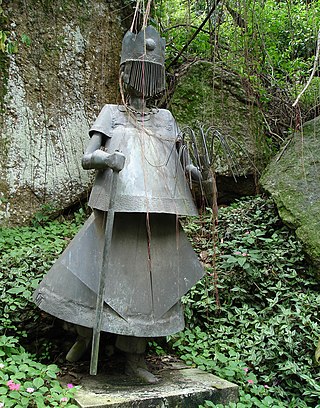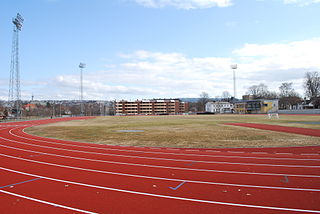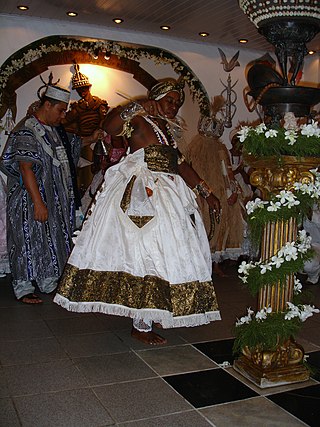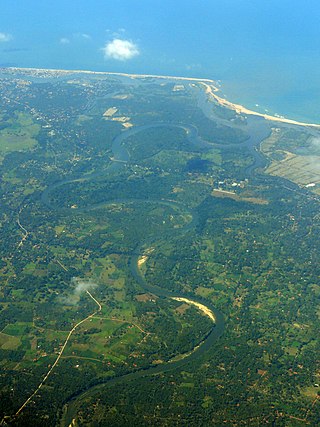Related Research Articles

Ọya is an Orisha of winds, lightning, and violent storms. As a river deity she is also regarded as a deity of children, able to provide children to her devotees or those who come to her banks at the Niger river.

Olorun is the ruler of the Heavens in the Yoruba religion. The Supreme God or Supreme Being in the Yoruba pantheon, Olorun is also called Olodumare.

Candomblé Ketu is the largest and most influential branch (nation) of Candomblé, a religion practiced primarily in Brazil. The word Candomblé means "ritual dancing or gather in honor of gods" and Ketu is the name of the Ketu region of Benin. Its liturgical language, known as yorubá or Nagô, is a dialect of Yoruba. Candomblé Ketu developed in the early 19th century and gained great importance to Brazilian heritage in the 20th century.

Egungun, in the broadest sense is any Yoruba masquerade or masked, costumed figure. More specifically, it is a Yoruba masquerade for ancestor reverence, or the ancestors themselves as a collective force. Eégún is the reduced form of the word egúngún and has the same meaning. There is a misconception that Egun or Eegun is the singular form, or that it represents the ancestors while egúngún is the masquerade or the plural form. This misconception is common in the Americas by Orisa devotees that do not speak Yorùbá language as a vernacular. Egungun is a visible manifestation of the spirits of departed ancestors who periodically revisit the human community for remembrance, celebration, and blessings.
Ota is a town in Ogun State, Nigeria with an estimated 163,783 residents. Ota is the capital of the Ado–Odo/Ota Local Government Area. The traditional leader of Ota is the Olota of Ota, Oba Adeyemi AbdulKabir Obalanlege. Historically, Ota is the capital of the Awori Yoruba tribe.

Yoruba literature is the spoken and written literature of the Yoruba people, one of the largest ethno-linguistic groups in Nigeria and the rest of Africa. The Yoruba language is spoken in Nigeria, Benin, and Togo, as well as in dispersed Yoruba communities throughout the world.

The Mahaweli River, is a 335 km (208 mi) long river, ranking as the longest river in Sri Lanka. It has a drainage basin of 10,448 km2 (4,034 sq mi), the largest in the country, which covers almost one-fifth of the total area of the island. The Mahaweli Ganga starts at Polwathura, a remote village of Nuwara-Eliya District in bank Nawalapitiya of Kandy District by further joining of Hatton Oya and Kotmale Oya. The river reaches the Bay of Bengal on the southwestern side of Trincomalee Bay. The bay includes the first of a number submarine canyons, making Trincomalee one of the finest natural deep-sea harbours in the world.

The Kotmale River is the longest tributary of Mahaweli River. The river begins as the Agra Oya, in the Horton Plains. The Central Plains have an annual rainfall of between 125 and 200 inches a year. The river is approximately 70 km (43 mi) long and drains a basin of about 58,534 ha. The river flows through a traditional area of ancient villages and tea plantations. King Dutugemunu spent his youth here. The Kotmale Oya flows into the Mahaweli at Pallegama. Tributaries of the Kotmale Oya include the Nanu Oya, the Pundalu Oya, the Puna Oya, and the Dambagastalawa Oya.

The Malwathu Oya is the second longest river in Sri Lanka. The river originates in the North Central Province of Sri Lanka and enters the sea on the northwest coast, into the Gulf of Mannar, near Vankalai. It is a seasonal river that spans over 164 km (102 mi) through paddy and forest lands, which are used by the inhabitants to cultivate for their survival.
Ofinran was a 16th-century king of the Oyo Empire in West Africa who succeeded Onigbogi as Alaafin after the latter had left for exile in Borgu with a few other Yorubas from Oyo. Ofinran was then made king in a foreign land and joined his host in expeditions around the Niger River and the two communities co-existed.

The Awori is a subgroup of the Yoruba people speaking a dialect of the Yoruba language.The Awori people are the original inhabitants of Lagos State and some parts of Ogun State, namely Ado-Odo/Ota Local Government Area of Ogun State. The Awori people are landowners, farmers and fishermen.
Oya is a town and the administrative centre of the subdistrict of the same name in Mukah Division, in the Malaysian state of Sarawak. It is located near the mouth of Oya River with the South China Sea. Oya is about 26 kilometres to the west of Mukah, the division's administrative town.

Øya stadion, also known as Trondheim stadion, is an athletics facility in Nidarø, Trondheim, Norway. The field was established as "Øen stadion" in 1900 as a combined athletics field and skating rink.

The Yoruba calendar (Kọ́jọ́dá) is a calendar used by the Yoruba people of southwestern and north central Nigeria and southern Benin. The calendar has a year beginning on the last moon of May or first moon of June of the Gregorian calendar. The new year coincides with the Ifá festival.
Isanlu Isin or Isanlusin is an ancient town in Isin LGA of Kwara State, Nigeria. Isin LGA of Kwara State was created from the old Irepodun Local Government Area in 1996 with the headquarters at Owu-Isin. Notable towns in Isin are Isanlu Isin, Ijara Isin, Owu Isin, Iwo, Oke-Aba, Oke-Onigbin, Alla, Edidi, Odo-Eku, Oba, Iji, Pamo, Oponda, Igbesi, Eleyin, Kudu-Owode, to mention but few. Collectively, these towns are today located in Isin Local Government area of Kwara State. The present ruler of Isanlu Isin also referred to as Olusin, is Oba Solomon Oluwagbemiga Oloyede.
Kali is a presumably moribund Mbum language of northern Cameroon or the Central African Republic.

Oshunmare is an Orisha. Osumare is the spirit of the rainbow, and Osumare also means rainbow in the Yoruba language.

Nanu Oya is a 27 km (17 mi) long stream in the Central Province of Sri Lanka. It originates at an elevation of over 2,000 m (6,562 ft) on Pidurutalagala, the highest mountain in Sri Lanka, flowing into the Kotmale Oya at an elevation of approximately 1,200 m (3,937 ft). The Kotmale Oya is a tributary of the Mahaweli River, the longest river in Sri Lanka, which finally discharges at Trincomalee after a combined distance of nearly 350 km (217 mi). The river was dammed in 1873 to create the popular Lake Gregory in Nuwara Eliya. The Nanu Oya discharges into the Kotmale Oya 2.5 km (1.6 mi) upstream of the Upper Kotmale Dam.
Leonce Raphael Agbodjelou, is a Beninese photographer.

The Deduru Oya is the sixth-longest river of Sri Lanka. The 142 km (88 mi) long river runs across four provinces and five districts.
References
- ↑ Babatunde, Abosede Omowumi (2022). "Reimaging Women Ritual Space: Gender and Power Dynamics in African Religion". The Palgrave Handbook of Africa and the Changing Global Order. Springer International Publishing. pp. 969–986. ISBN 978-3-030-77481-3 . Retrieved 16 February 2024.
